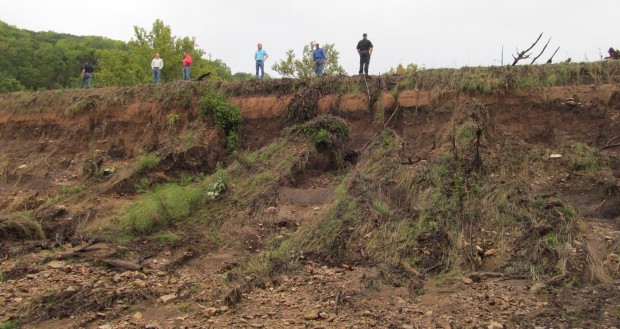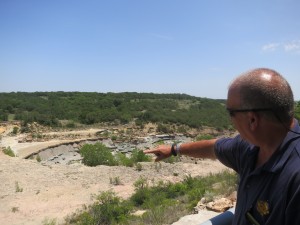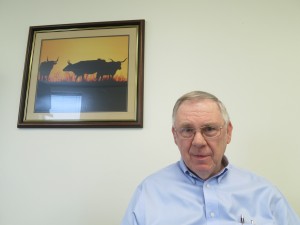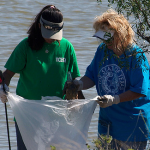Why So Many Dams In Texas Are in Bad Condition

Photo from TCEQ
This picture of a dam that over-topped is used in dam safety workshops presented by the TCEQ.
This is part one of a StateImpact Texas series devoted to looking at the infrastructure of dams in Texas, and what can be done to improve it.
Of the 1,880 dams inspected by the TCEQ since 2008, 245 were found to be in bad condition, according to the Texas Commission on Environmental Quality. Around 2,000 of the state’s dams were built with federal help in the wake of the great drought of the 1950s. Almost all of those are now past or nearing their projected 50-year lifespan, according to the American Society of Civil Engineers.
Statistics like these don’t come as a surprise to the people who work with dams in the state of Texas.
“We’ve traveled and looked at different dams just to make sure that we do things right. And there’s a lot of dams that we did come across that would scare me to live downstream from them,” Troy Henderson, Chief of Lake Patrol for the Brownwood Water Improvement District, told StateImpact Texas this summer.
Part of Henderson’s job is maintaining the dam at Lake Brownwood, something he and his team take very seriously.
“Downstream is the population of Brownwood and Early, and if we have a dam failure it’s going to be catastrophic,” he said.
The challenges confronting the state’s infrastructure of dams is underscored by the fact that Texas has more than 7,300 dams, more than any other state. There is, in fact, only one natural lake in the entire state of Texas.

Mose Buchele
Troy Henderson, with the Brownwood Lake Patrol, shows where erosion has eaten at a dam's spillway.
But many public safety officials and engineers say it’s difficult to get people to pay attention. Major floods continue to strike Texas periodically. Central Texas, for example, was just hit by flooding this weekend. But it’s the continuing drought that policymakers appear most concerned with.
But if Texas experiences the type of historic rain event that will likely be necessary to free it from drought, will the state’s infrastructure be prepared? Many experts say no.
Wes Birdwell, a civil engineer, says the situation reminds him of the old tune “The Arkansas Traveler.”
“‘My roof doesn’t leak when it doesn’t rain,’ the old song says,” he told StateImpact Texas at his Austin office.
To explain the problem, Birdwell described a hypothetical dam.
“Say your great grandpa got home from World War I and he had an army surplus bulldozer,” Birdwell said. “And he bought this piece of property with his GI Bill. And he went and got his bulldozer and he scraped some dirt up, and he built a dam it’s been there for 80 years. He fished on it, and your dad fished on it. And there’s never been a problem.”
Then, one day a ranch downstream is sold to a developer. Houses start going up. And you start looking at that old dam a little differently. Now lives and property are at risk if it fails. And it’s your responsibility to make sure that doesn’t happen.
“Now suddenly, you’ve gotta spend all this money. That is a problem,” said Birdwell.
‘We Want to Fix This’
“There is no place for owners to go to go get money if they want to rehabilitate their dam,” Warren Samuelson, the manager of the Dam Safety Program with the Texas Commission on Environmental Quality, told StateImpact Texas, when asked about the challenges his department faces.
Samuelson says about 60 percent of dams in the state are privately owned. Many of those owners couldn’t afford to rehabilitate their dams even if they wanted to.
“We have a lot of people call us and say ‘we want to fix this. But we have no money to do it,’’ Samuelson said. “And it’s not just [homeowner’s] associations. A lot of it is cities. A lot of their source of money could be taxation, but are you willing to tax people for additional funds? And it’s a political issue.”
Samuelson would like Texas to set up a fund that could aid cash-strapped dam owners. Of course, earmarking funds for that is political, too. And, so far, Texas lawmakers have been uninterested.
In the past, his division has also sought greater power to enforce dam upkeep, but Samuelson said those powers were not given to them by lawmakers.
So what reforms have legislators backed? This year, instead of beefing up enforcement, lawmakers reduced the number of dams that will be inspected. Something that engineer Wes Birdwell says could put lives and property at risk.
“Any time we decrease the size of the safety net, there’s probably reason for concern,” he told StateImpact Texas.
Learn more about that tomorrow in the second part of our series on the state of dams, in the state of Texas.

